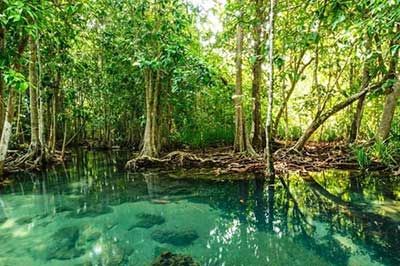Relevance: GS-3: Conservation, environmental pollution and degradation, environmental impact assessment
Key Phrases: Applied Environmental Research Foundation, Conservation International, Raigad district of Maharashtra, carbon neutral, blue carbon finance project, Restore Fund, Power for Impact program.
Why in News ?
- Recently, Apple announced a new partnership with the Applied Environmental Research Foundation and Conservation International to protect the mangrove ecosystem and the people's livelihoods in the Raigad district of Maharashtra.
- Apple awarded a grant to the Applied Environmental Research Foundation (AERF) in 2021 to work with the local community to protect a 2,400-hectare mangrove forest in the region. The region “provides an important buffer against the most dangerous impacts of climate change”.
- Through the partnership, AERF will enter into conservation agreements with local community members, offering support in exchange for conserving and protecting the mangroves on their land.
- These efforts are part of Apple’s broader goal to become carbon neutral across its entire global supply chain by 2030.
Aims of the partnership:
- Sustainable Transition of the Economy:
- The main goal of the partnership is to help transition the local economy to one that relies on keeping mangroves intact and healthy.
- Sustainable Transition of livelihood without compromising with income and food security.
- Mitigation against Climate change :
- The fight against climate change is a fight for the communities around the world whose lives and livelihoods are most threatened by the crisis.
- It will help communities to benefit economically from the restoration of the mangrove forests that protect against the worst impacts of climate change.
- Also engage Conservation International to verify the climate benefits of the mangroves, accounting for the carbon sequestered in both the trees and soil.
- Expansion of Carbon Sink:
- Apart from protecting coastal communities from climate impacts like the unpredictable monsoons and rising tides, Mangroves act as carbon sinks that absorb carbon dioxide from the atmosphere and store it in their soil, plants, and other sediments.
- To collaborate with Conservation International is a great opportunity to explore different ways to supplement the carbon sink footprint.
- Capacity building of Locals:
- Since mangrove conservation issues are diverse and different in each place, capacity and training according to the needs are vital.
- Training our young, enthusiastic team as well as local communities for Conservation and protection will surely help to achieve mangrove conservation in this vibrant coastal area along the Arabian Sea.
- Improved accounting standards:
- Conservation International’s blue carbon finance project will adequately and accurately measure the carbon that mangrove trees store in their trunks and leaves and what they sequester in their soil.
- The improved accounting enables communities to benefit from the full economic value of the ecosystems they sustain.
- AERF will apply the learnings from the Colombia project to their work in Raigad, with plans to establish a model that can be scaled across India.
- Apple’s other sustainable environmental efforts:
- It will also support purchasing and distributing portable bio-stoves, enabling people to cook without cutting down mangroves for firewood.
- Apple will continue to focus on communities most impacted by climate change as it pursues its environmental goals through the company’s $200 million Restore Fund
- Apple will make investments in forestry projects that aim to remove carbon from the atmosphere while generating a financial return for investors.
- The tech major also provides under-resourced local communities worldwide with access to renewable energy through its Power for Impact program.
Do you know about the Mangrove Ecosystem?
- Mangroves are generally found along the coastlines of tropical and subtropical regions, between 25 degree N and 25degree S latitude, throughout the world.
- Mangroves are located all along estuarine areas, deltas, tidal creeks, mud flats and salt marshes.
- India has some of the best mangroves in the world.
- About 380 km or 6% of the coastline of mainland India is covered by mangroves, while 40% of the coasts (260 km) of Andaman and Nicobar are lined with mangroves.
- They are located in the alluvial deltas of rivers. The Sundarbans of West Bengal represent the largest stretch of mangroves in the country.

- The mangrove is a specially adapted salt-tolerant tree. They are characterized by dark green foliage and a network of many stilt-like roots that support them above water.
- The mangrove swamps are highly productive and are an important nursery ground for fish, crabs and prawn.
- They are an essential habitat for spawning and nursery bed of marine fishes, endangered migratory birds, estuarine crocodiles, dugongs, dolphins, Royal Bengal Tiger, Olive Ridley turtles and sea otters.
- The wood, leaves and bark of mangroves are used mainly as fuelwood, thatch and for tanning leather respectively.
Role of mangrove ecosystem
- Act as a cost-free, self-repairing and static border security force, for protecting the coast from erosion by storms, cyclones and floods.
- The thousands of stilt-like roots catch silt (mud deposits) at the mouths of streams, slow down the current and help the silt to settle.
- Support a vast range of biodiversity.
- Act as a natural sewage treatment plant.
- Absorb pollution, including heavy metals.
The principal reasons for degradation
- Dependence of coastal population on mangroves for domestic fuel needs.
- Decreased freshwater discharge and increased salinity.
- Unchecked expansion of salt pans and aquaculture along the coast.
Conclusion:
- All of these efforts are part of Apple’s broader goal to become carbon neutral across its entire global supply chain by 2030.
- Apple has also made significant progress toward its goal to eliminate plastics from its packaging by 2025. Since 2015, Apple has reduced plastic in its packaging by 75 per cent.
- These efforts by a global major tech will surely motivate other MNCs to adopt a carbon neutral path for decarbonisation of economy.
Source: The Hindu BL
Mains Question
Q. Corporate sector should play a proactive rather than passive role against the global warming induced climate change. Elaborate. (10 marks)








